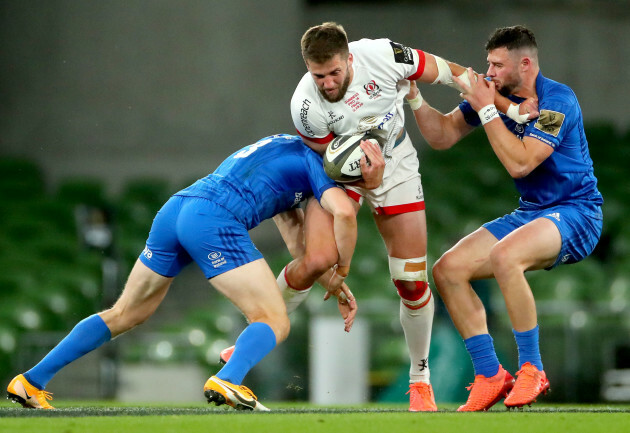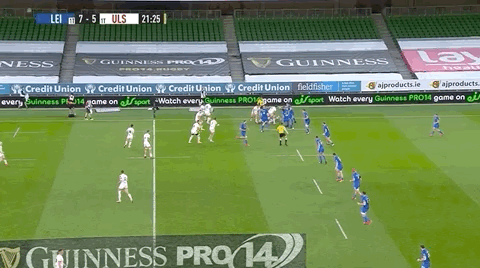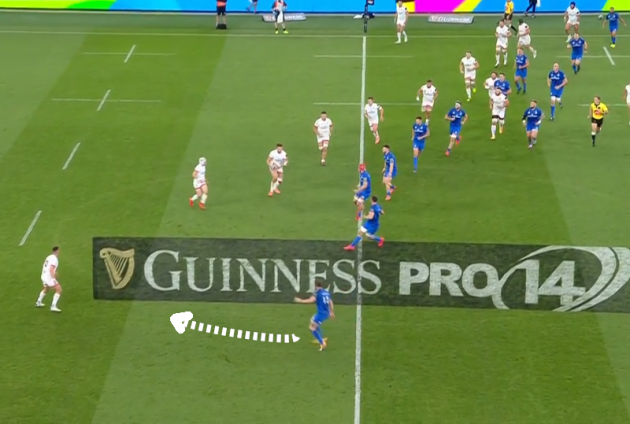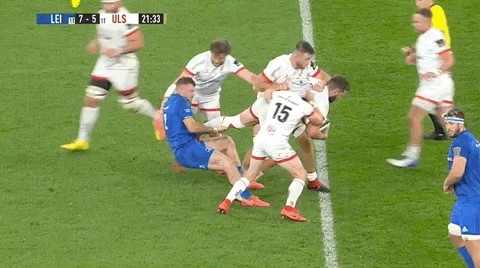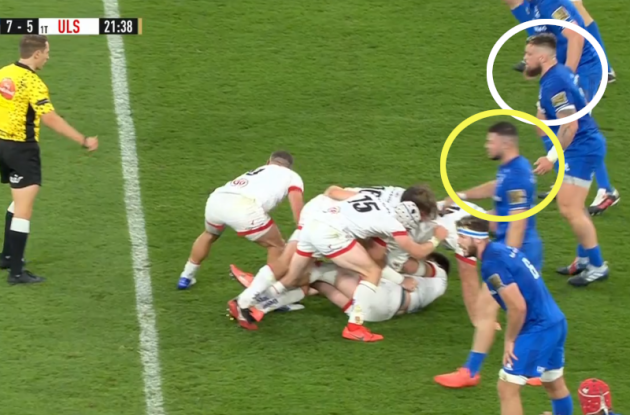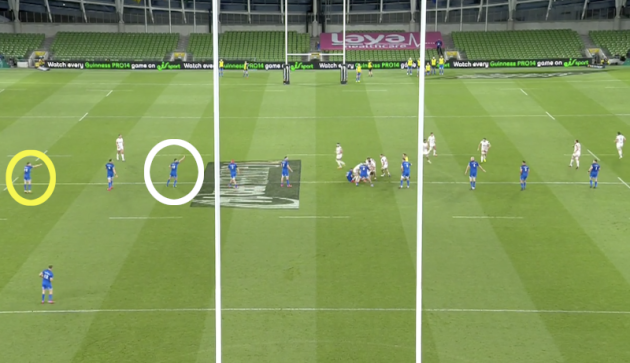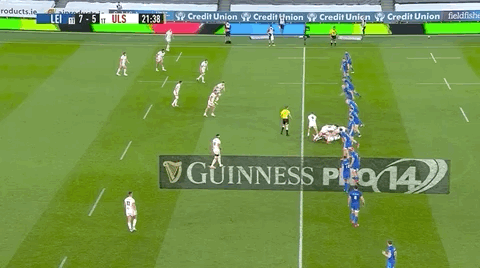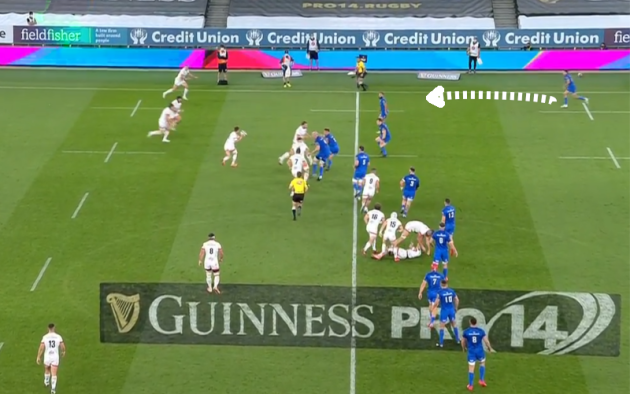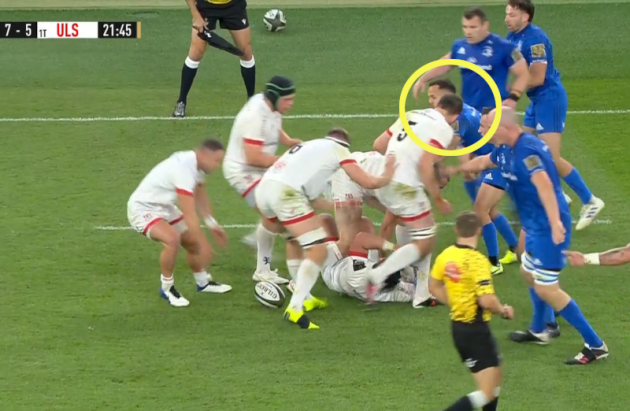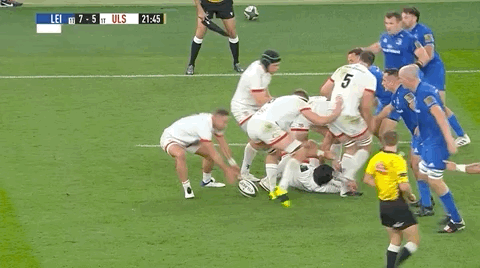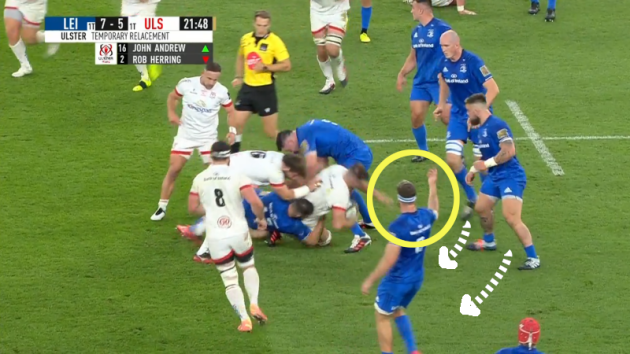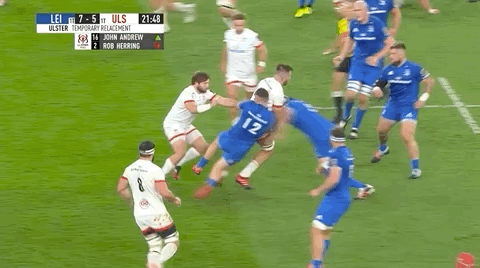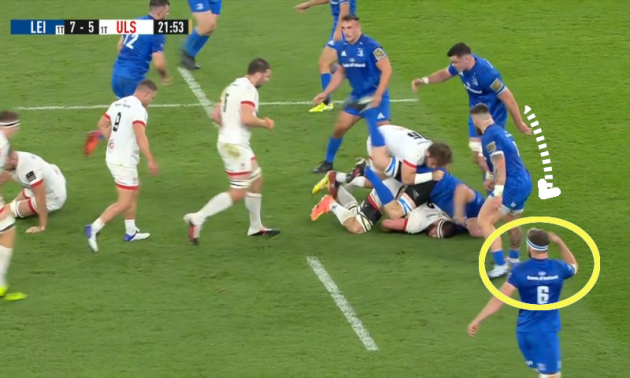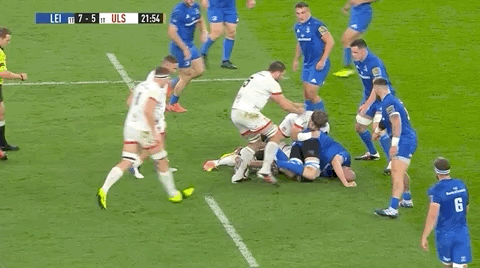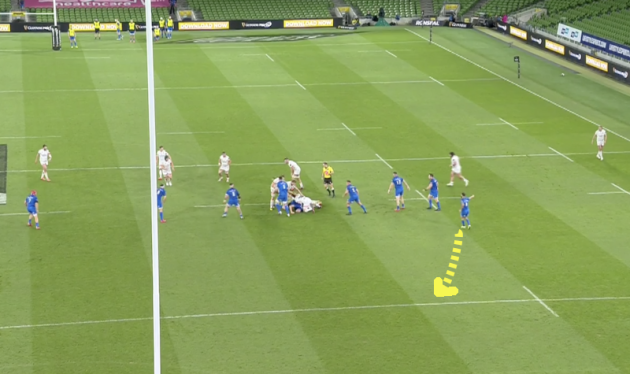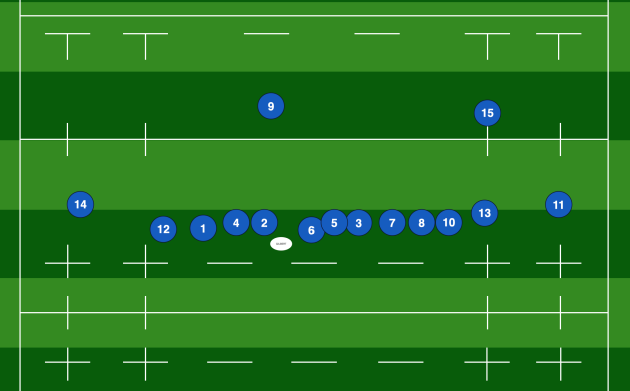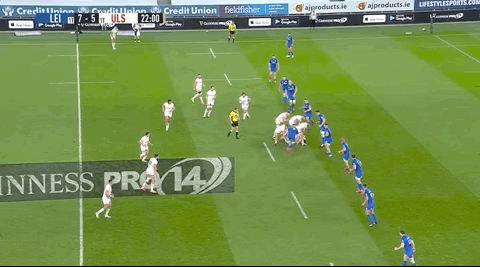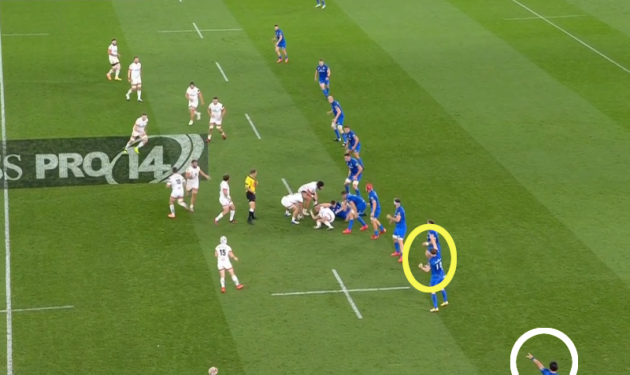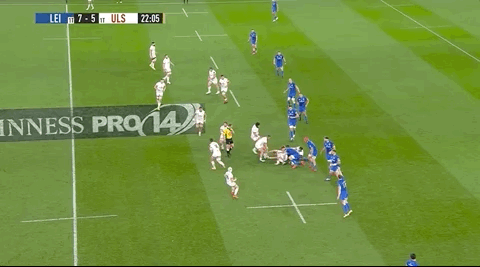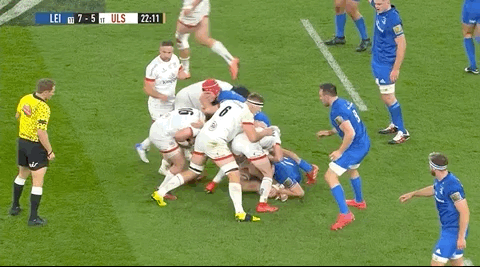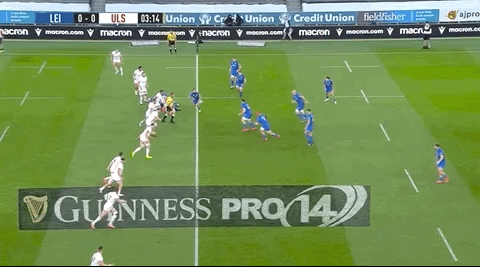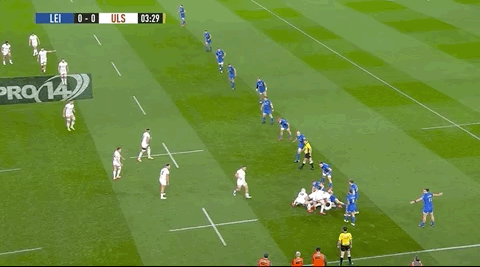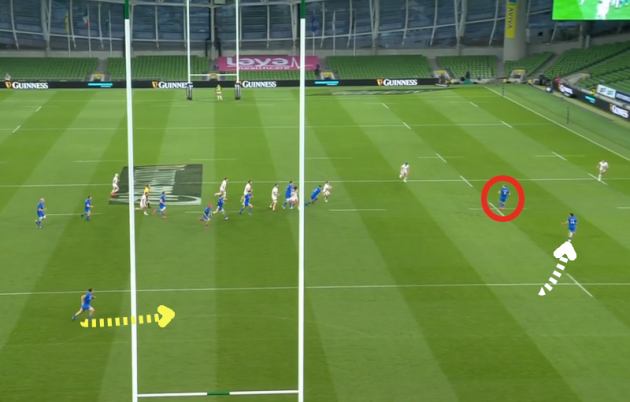THERE WERE MOMENTS on Saturday night where Ulster must have felt like there was simply nowhere to go.
Dan McFarland’s men hogged the ball in the Guinness Pro14 final – spending just over 22 minutes of the game in possession compared to Leinster’s 16 minutes – but after a very promising start, they struggled to break down the champions’ relentless defence.
Indeed, Ulster’s only two linebreaks of the game came in the fourth minute from Stuart McCloskey and James Hume as the latter scored the opening try.
Thereafter, the blue wall in front of Ulster was impenetrable, with Leinster making 200 tackles and missing just 15 in an impressive show of the defensive might that has been a key part of their game in recent seasons.
Leinster’s defence will need to be close to perfect for Saturday’s Champions Cup quarter-final against Saracens, who are likely to bring a ferocious challenge as they defend their European title.
Leinster’s display against Ulster underlined some of the attributes that Leo Cullen and Stuart Lancaster’s side show consistently in defence, including a huge work-rate, clear-headed decision-making, strong communication, and technical excellence in contact.
A first-half passage of defence provides examples of all of these things, with Leinster forced to defence after Hugo Keenan knocks-on Alby Mathewson’s box kick, one of Ulster’s four successes in this area.
Leinster react well, working to get back onside and then bringing linespeed as Ulster try to move the ball wide.
Ross Byrne leads the line up initially and then we can see Leinster captain Garry Ringrose closing up on the edge of the defence to get into McCloskey’s eyeline and dissuade him from passing.
McCloskey tucks and carries into Robbie Henshaw, who dips and targets the big Ulster centre’s legs.
Next, we see some early decision-making from Leinster as Andrew Porter sniffs a possible turnover opportunity but then recognises that McCloskey has support and steps away.
Porter appeals for a penalty, calling “off his feet” but referee Andrew Brace says, “No, you’ve stepped away, three. Play on.” This kind of ‘matador’ play at the breakdown is something referees are keen not to reward.
Either way, Porter [white below] hasn’t committed into a contest he’s unlikely to win, while Henshaw [yellow] is straight back up onto his feet and into the defence again.
So while Ulster have four players tied into the breakdown here, Leinster have none.
All 15 of their defenders are on their feet ready for the next phase – something they specialise in.
As highlighted on the Guinness Pro14′s Analyst Eye last week, Leinster had either 14 or 15 defenders on their feet for 69% of all phases they had to defend in their three games leading up to the final against Ulster.
It’s a phenomenal statistic that sometimes means Leinster end up with defensive overloads, although in the passage at hand here, they would have been slightly disappointed with the next phase of their defence.
As we can see below, Byrne [white] and Ringrose [yellow] are communicating for a ‘fold’ across to the right-hand side of the defence.
Ideally, Leinster would fold at least one more defender – Henshaw or Caelan Doris – across in this instance but it does at least underline how players are scanning what’s in front of them and communicating to team-mates.
Midfield rucks are always difficult to defend from and Ulster make forward progress in this instance, as nice handling from Matty Rea, Billy Burns, and Eric O’Sullivan allows Tom O’Toole to get up to Leinster’s 10-metre line.
The threat wide on Leinster’s right draws Keenan [white below] up from the backfield, where he has been occupying possible kick space along with fullback Jordan Larmour…
… but it’s scrum-half Jamison Gibson-Park who has to make the tackle on Moore.
Note how quickly Gibson-Park [yellow below] is back on his feet, sling-shotting himself up off the ground even as he completes the tackle, meaning Leinster have 15 defenders on their feet again.
Meanwhile, Ulster have five players committed into this breakdown.
With Leinster having numbers on their feet and Ulster playing off the touchline, this is a prime chance for Cullen’s men to turn on the linespeed again.
Leinster’s third or fourth defender out from the ruck repeatedly brought aggressive linesepeed in this game to shut down Ulster’s decision-making time.
That was important as McFarland’s side like to employ tip-on or tip-in passes from their forwards, or else play off out-half Billy Burns to three-man pods of forwards. Leinster’s linespeed often suffocated the Ulstermen’s ability to play in these areas.
Henshaw combines with James Ryan to stop Alan O’Connor above, and we see more evidence of the Leinster communication.
Doris [yellow above] is calling for Porter and Devin Toner [white] to fold to the left and they respond, leaving Toner well-positioned to deal with Ulster’s next attacking thrust…
Marcell Coetzee wins a few metres for Ulster but Leinster are still calm and clear-headed defensively.
Doris [yellow below] appeals for the fold again and Ryan [white] responds.
That leaves Doris well-positioned to make the next tackle on Eric O’Sullivan.
Again, note Porter’s decision-making around the breakdown.
The tighthead is one of Leinster’s strongest jackals and he won a breakdown turnover in this game, but their policy around attacking the ball on the ground post-tackle is selective.
Keen to have 14 or 15 defenders on their feet as often as possible, Leinster only go for the poach when it is very clearly on. They don’t accept any wasting of bodies looking for glamorous turnovers when failure can leave the defence exposed.
Here, Porter folds around the corner along with Ryan, as Doris works back to his feet.
Meanwhile, it’s important to highlight that Leinster have their backfield well covered too. Just as O’Sullivan is getting set to carry into Doris’ tackle, Gibson-Park [yellow below] is dropping out of the frontline.
Gibson-Park is communicating to Keenan to stay up in the frontline as the scrum-half drops off to fill possible kick space along with fullback Larmour.
With James Lowe high on the left edge of Leinster’s frontline, this leaves them with a basic 13+2 set-up.
We can see the set-up below.
The positioning of Gibson-Park and Larmour is obviously important in denying Ulster any obvious kick space behind the frontline, while the 13 players in the frontline get great width across the pitch.
Ulster continue to look for a way through Leinster here, as McCloskey gets back on the ball and plays a short pass to James Hume on his outside shoulder.
Leinster’s linespeed from the third, fourth and fifth defender is impressive in limiting Ulster’s decision-making time, although Burns could potentially have made life more difficult here by looking like a more genuine threat out the back.
As it is, Byrne can make a straightforward read and commit inwards to tackling Hume early, combining with Jack Conan to ground the Ulster centre.
As Conan works back to his feet, Porter, Doris and van der Flier all race to fold around the corner but Ringrose and Lowe identify that Leinster don’t need all of them on this left-hand side.
Ringrose [yellow above] and Lowe [white] are signalling that Ulster have more attacking bodies on Leinster’s right, but we can also see above that the attacking players are not well set up to go at the defence, which is once again well-organised and ready to tackle.
Instead, Ulster continue to play to their right, where Leinster essentially have an overlap in defence.
Keen to fully take advantage of this numerical overload, Ringrose bites a long way in to tackle ball-carrier Sean Reidy.
With Ringrose dropping in low around Reidy’s legs as van der Flier looks to wrap up the ball, a maul forms and hooker John Andrew opts to carry off to the right.
Conan, who was Leinster’s busiest tackler with 20 on Saturday, meets Andrew with a dominant tackle.
Conan drives the Ulsterman backwards and now Leinster identify the ideal opportunity for that jackal effort.
Doris is the man to get over the tackle before the Ulster support arrives and, with his hands clearly on the ball, he earns the penalty turnover for Leinster.
This strong defensive passage eventually results in three points for the champions, as they kick down the left touchline and apply pressure to win a penalty that Byrne slots for a 10-5 lead.
The passage above sums up so much of what was good about Leinster’s defensive performance against Ulster, with these traits magnified inside their own 22.
As they went to a 14+1 set-up, with Larmour patrolling in behind on his own, Leinster’s work-rate counted for even more as Ulster struggled to create any numbers-up situations and were constantly repelled by double tackles.
That said, Leinster are in the ideal situation of having work to do on their defence ahead of the Saracens clash. The concession of that fourth-minute try to Hume will have frustrated them.
The opportunity comes from a simple Leinster error as Conan knocks-on and Ulster spring onto the counter-attack.
McCloskey thunders forward into space off Burns’ pass and makes headway for Ulster.
On the second phase, we see van der Flier bringing that linespeed as the third defender out from the ruck but Coetzee does well here.
Fullback Michael Lowry steps in at scrum-half to pass to Coetzee, who uses his footwork to evade the onrushing van der Flier and then offloads to Rea on his outside.
Leinster will possibly feel they could have folded another player over to their right here and they will have been very disappointed to get cut open by some sharp Ulster play.
Ulster out-half Burns passes to lock Alan O’Connor, who plays a nice link pass out the back of O’Toole to Hume in behind the three-man pod.
Hume shows his acceleration to break outside Leinster’s Ronan Kelleher, who made some huge hits amongst his 18 tackles on Saturday, but the hooker has been left exposed here.
We saw earlier how stifling the width of Leinster’s defence can be but their desire to keep width sees them punished in this instance.
As we can see above, Doris [red] has set up very wide defensively for Leinster, leaving almost 20 metres of space on Kelleher’s outside shoulder.
Doris appears to be worried about Ulster wing Jacob Stockdale but we can see that Keenan [white] is closing up on that edge, while the second Leinster backfield defender, James Lowe [yellow] is working across from the left-hand side.
Doris’ positioning leaves Kelleher exposed as he has to initially respect O’Toole’s decoy line and then can’t recover against the accelerating Hume.
The 22-year-old Ulster centre takes advantage impressively as he hitch-kicks to the outside of Lowe and then finishes through Keenan’s despairing tackle attempt.
It’s an excellent Ulster score on turnover ball but Leinster will have been frustrated with their shortcomings as they now look to produce a perfect defensive performance against Saracens.
